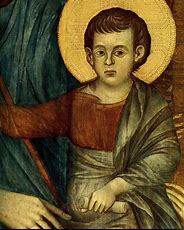Between Greek and Latin manner: Cimabue
I want here consider a work that is attributed from Vasari to Cimabue (1240-1302),
a painter that has seen and studied Giunta Pisano and he was master of Giotto
too. But the plastic and characteristic physical presence of figures on Giotto
painter, that we can see on painters of Assisi, has origin from Cimabue, and we
can document this relevance plasticity on a work of Cimabue(Figs.1-3) that is a
contradiction between will of costumer, because Greek manner is certainly will
of costumer, and will of Cimabue, this is plasticity, that he has used both
Madonna of Servi(Fig.4), Bologna datable around 1280-1285 and Madonna on the
throne(Fig.1), datable around 1302, date of die Cimabue’s. We must consider
that Cimabue has worked cloth of these Madonna with a freedom very much strong,
because the figures of angels and lines of figures are very worked and
plastics, and has passed the rigid line of Christ(Fig.5), because by now the
Greek manner is memory of some less painter, by now, Giotto and his presence in
Assisi has given form and plasticity to figures; certainly this judgment is
right, but we must consider that the Madonna of Servi is former that Madonna of
Louvre, and we can see both plasticity and form of same master, then we must
consider that plasticity of Giotto is logic outcome of form that Cimabue has
used former, although it isn’t so evident how Giotto.
Alessandro Lusana
Fig.1





.jfif)

Comments
Post a Comment